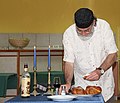Shaʽar HaGolan
Shaʽar HaGolan
שַׁעַר הַגּוֹלָן | |
|---|---|
 | |
 Shaʽar HaGolan | |
| Coordinates: 32°41′11.4″N 35°36′11.87″E / 32.686500°N 35.6032972°ECoordinates: 32°41′11.4″N 35°36′11.87″E / 32.686500°N 35.6032972°E | |
| Country | |
| District | Northern |
| Council | Emek HaYarden |
| Affiliation | Kibbutz Movement |
| Founded | 21 March 1937 |
| Founded by | Czechoslovakian and Polish Hashomer Hatzair members |
| Population (2019)[1] | 543 |
| Name meaning | Gate of the Golan |
| Website | www |
Shaʽar HaGolan (Hebrew: שַׁעַר הַגּוֹלָן, lit. Gate of the Golan) is a kibbutz situated at the foot of the Golan Heights in the Jordan Valley area of north-eastern Israel. Located less than 1 km from the border with Jordan, it falls under the jurisdiction of Emek HaYarden Regional Council. In 2019 it had a population of 543.[1]
History[]
Sha'ar HaGolan was founded on 21 March 1937 by members of the Hashomer Hatzair youth movement from Czechoslovakia and Poland. The founders met and were organized as a team in 1930 in Rishon LeZion and were called "Ein Hakore" until 1937, when they established the kibbutz as a tower and stockade settlement.
During the Battles of the Kinarot Valley in the 1948 Arab–Israeli War, the defenders of Sha'ar HaGolan and of neighbouring kibbutz Masada, after withstanding a first Syrian attack and further aerial bombardment and shelling, retreated due to lack of reinforcement and direction. The kibbutzim were captured and briefly held by the Syrian Army, during which time they were looted and burned down. Although the members soon returned, a stigma was attached to them, and vindication in the form of released military records only arrived in recent years.[2]
Economy[]
The main source of income is a plastics engineering factory. The kibbutz also grows bananas, avocado and watermelons, and has a herd of dairy cows. Another economic sector is tourism, one of the attractions on a museum of Yarmukian culture exhibiting pre-historic Neolithic findings discovered along the banks of the Yarmuk River.[3] Established in the 1950s, it was Israel's first museum of prehistory.[4]
Archaeology[]
Excavations at Sha'ar HaGolan unearthed an 8,000-year-old village and artifacts that include the first pottery cooking pots found in the Land of Israel. This Neolithic Yarmukian village was inhabited by the people who abandoned their nomadic lifestyle in favor of permanent settlement, marking the shift from hunting and gathering to agriculture.[4]
Galleries[]
- Sha'ar HaGolan 1937

Sha’ar HaGolan from Kibbutz Masada 1937

Sha’ar HaGolan 1937

Sha'ar HaGolan 1937

The watchtower being erected at Sha'ar HaGolan, 21 August 1937
- Kibbutz Sha'ar HaGolan 2010

Guesthouse

Canteen

Kindergarten

Postboxes

Chorisia Insignis

Aloe

Artwork

Sabbath celebration
Notable residents[]
References[]
- ^ Jump up to: a b "Population in the Localities 2019" (XLS). Israel Central Bureau of Statistics. Retrieved 16 August 2020.
- ^ Nadav G. Molchadsky (2015), "Living in the Shadow of Shame: Masada and Sha’ar ha-Golan," in History in the Public Courtroom: Commissions of Inquiry and Struggles over the History and Memory of Israeli Traumas (Ph.D. Dissertation, University of California, Los Angeles), pp. 76-118. Also see Zionist mythology destroys its children Haaretz, 6 April 2006
- ^ Archaeological Excavations at Sha`ar Hagolan - A Neolithic Art Center in the Jordan Valley, Israel Hebrew University of Jerusalem
- ^ Jump up to: a b Vered, Ronit. "For All Tastes". Haaretz.
External links[]
- Emek HaYarden Regional Council
- Kibbutzim
- Kibbutz Movement
- Populated places established in 1937
- Jewish villages depopulated during the 1948 Arab–Israeli War
- Prehistoric sites in Israel
- Archaeological sites in Israel
- Neolithic settlements
- Populated places in Northern District (Israel)
- 1937 establishments in Mandatory Palestine
- 1948 disestablishments in Israel
- Czech-Jewish culture in Israel
- Hungarian-Jewish culture in Israel
- Slovak-Jewish culture in Israel












